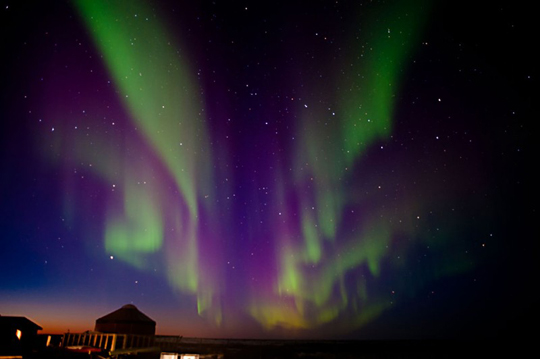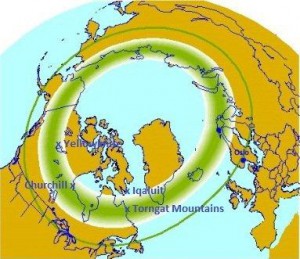
2013 should be a great year at the Lodge for the Northern Lights!
2013 is being forecast as an unbelievable opportunity for star gazers to witness an Aurora Borealis year like few others. Churchill Wild is hoping for just that!
Just as the earth has cycles which we call seasons, the sun’s energy output also has changes. These changes occur roughly every 11 years. We call these changes the solar cycle. During the last cycle, there were few magnetic storms on the sun, sunspots were rare, and geomagnetic disturbances on earth were nearly nonexistent. We are now however, five years into a solar maximum cycle which is approaching its projected peak in 2013.
As far back as 2006, solar scientists began predicting that our next solar maximum would be one of the strongest yet. The next sunspot cycle will be 30% to 50% stronger than the previous one. If correct, the year ahead could produce a burst of solar activity second only to the historic Solar Max of 1958. So what can happens during this predicted solar season?
Sunspots increase and harbor more energy. At times, this energy is released in the form of coronal mass ejections (CMEs). A CME consists of plasma from the sun itself — electrons and protons — with an accompanying magnetic field.
When the charged particles strike the earth’s magnetosphere, they travel down the magnetic field lines to the poles, colliding with atoms in our atmosphere along the way. These collisions can create an Aurora Borealis display that can incredibly be seen as far south as Mexico during strong solar events.
Everyone here at Churchill Wild is keeping their fingers crossed for clear and cloudless nights in 2013, so we can all enjoy the show.
One of the best places in the north to see the Aurora Borealis is at Dymond Lake Eco-Lodge in our custom made Aurora Viewing Platform during our Great Ice Bear Adventure. Spots are filling up for this one-of-a-kind wilderness safari as Aurora and polar bear enthusiasts worldwide are anticipating an incredible viewing season.
We hope you’ll join us!









Question, what dates are available to see the aurora boreal and are there also opportunities to see polar bears at the same time frame?
Hi Donald – Although the Northern Lights can be seen to varying degrees throughout the year the best time to see the Aurora is on our Great Ice Bear Adventure. We still have availability so contact our office by calling 204-377-5090 or by emailing to info@churchillwild.com